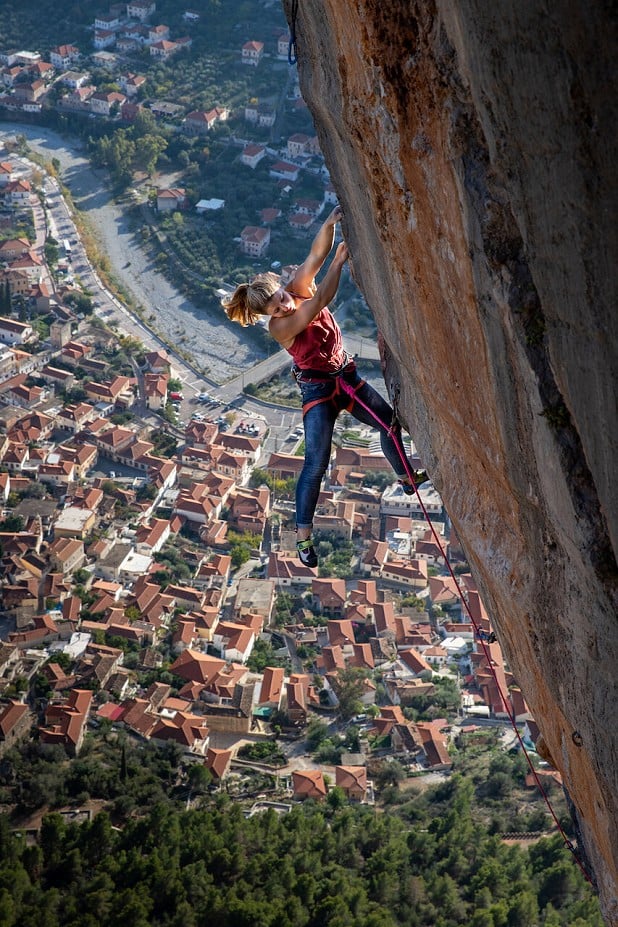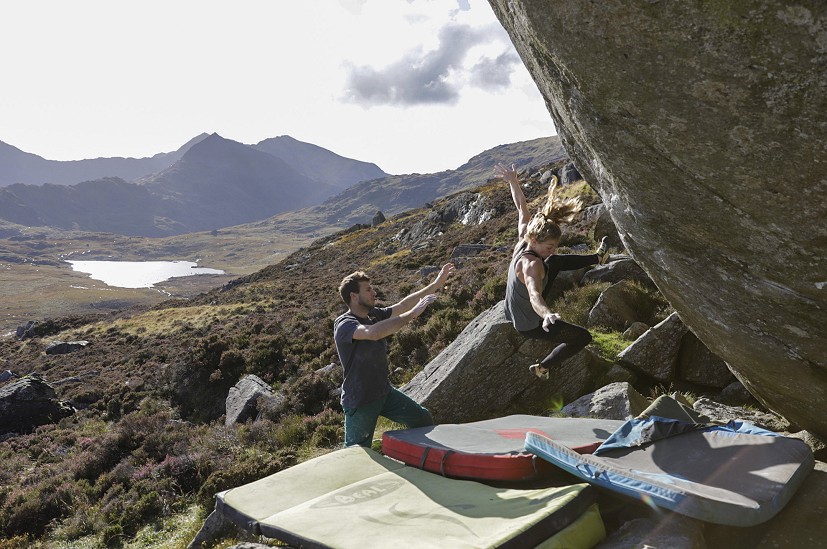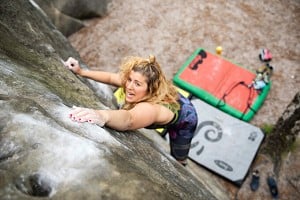
Hazel Findlay shares the bad habits that climbers can pick up - and fall into - when it comes to practising falling...
Fall practice is a slightly sticky subject in climbing. Aside from being neglected or completely overlooked, it's often done badly. Common misconceptions in the climbing world often go against what science tells us about deconditioning fear. And not only is a bad fall practice less effective, it's more dangerous, often ingrains fear and perpetuates the idea that we can't or shouldn't train our minds for climbing (or falling!).
A common mistake is to think that fear of falling is this weird thing that proper climbers wouldn't have. But fear of falling doesn't mean you have some sort of pathology, it just means that one of the most common and innate fears on the planet can distract you from a complex, highly skilled task. It's something that 90% of climbers have.
Here I'll list some of the critical ways climbers go wrong when practising falls. I'll bust a few myths we often hear and establish some important principles for safe and effective fall practice. I'll also have a poke at our climbing culture and the way we've approached falling in the past – as you'll see, I think this exposes some bigger issues that we have in climbing.
So where do climbers go wrong with fall practice?
1. Avoiding falling altogether
No-one gets more comfortable with falling by not doing it. But some climbers think that falling is something you can't or shouldn't practise. This might be because they've seen ineffective fall practice – I can really sympathise with you there, our common intuitions don't always lead us to safe and effective practice – or they believe you just can't train that kind of thing at all.
This idea that we can't train our minds is a grave misconception and a troubling line of thinking. We can learn to be more comfortable with falling and I've taught thousands of climbers to do it (if you're not convinced of adult neuroplasticity, please Google it, there's no shortage of evidence).
And if climbers can't train their minds, then we're expected to already have these skills when we come to the sport – you're either cut out for climbing or you're not. Since that's not true, this ends up being a very exclusionary view that leaves out lots of would-be climbers because they don't have the gung-ho attitudes of the people that hold that view. This often cuts down demographic lines: we find women are less likely to be reckless about falling, so this reckless attitude tends to exclude them whilst perpetuating a stifled culture.
And anyway, falling is a physical skill, as is catching a fall as a belayer. If we don't practise these skills, how are we expected to do them well and safely? Wait until the big moment when we take a real fall and hope that being scared and inexperienced doesn't make falling dangerous? (Spoiler: it really does!).
2. Not falling enough
Apart from not practising at all, climbers often do very little falling whilst still hoping they will become more comfortable with falling. No one would expect their fingers to get stronger from hanging off a fingerboard once or twice – we need regular training for a sustained period to see results. The same goes for training our minds; we need to build falling into our climbing as a habit before we can see the results we want.
It's also common to think that because we've fallen before, we're comfortable with falling. But there are countless different falls we could take and one fall doesn't prepare us for all of them. Someone who has taken many falls also knows what will happen when they fall, which removes much of that 'unknown' that people are especially afraid of before a fall.
3. Taking falls we're not ready for
Many climbers feel that if they take a big fall, that will make them more comfortable with all sizes of falls. It's a common intuition to have, but it's like assuming that jumping in a bath of tarantulas will cure you of your fear of spiders. Most of us know intuitively that if you suddenly hang an extra 50kg from yourself while fingerboarding, you fingers won't suddenly get stronger, you'll probably get injured.
Similarly to physical training, much of mental training is about getting the load and intensity right. Many people try to take falls they're not ready for and instead of growing more comfortable with falling, they actually become less comfortable because they have stressful experiences and they ingrain fear. This is akin to an injury of the mind. We've coached so many climbers who have forced themselves (or been forced) to take a fall they're not ready for and the consequences of a micro trauma can be more disastrous for your climbing than a pulley tear.
4. Rushing the fall
Many people can fall off so long as they do it so quickly that they don't have time to be scared. This is quite different to being comfortable with falling, in particular with the anticipation of falling.
The moments before the fall are often the most uncomfortable. If we don't take time before the fall we never learn to be comfortable with that apprehension. This apprehension of a fall often affects our climbing more than the fall itself – we spend far more time anticipating a fall, and in this way we can experience fear of falling even if we don't fall at all.
What's more, if we don't take time before the fall, we don't always know that a fall is an appropriate level of challenge/stress for us. This is often how people end up taking falls they're not ready for and further ingrain fear.
5. Jumping off, rather than falling off
It's also common for people to practise jumping off rather than practise falling. We see this a lot in bouldering fall practice, but the same happens in roped climbing – we see climbers look down and check their landing rather than fall off in a climbing position.
We want fall practice to be as close to climbing as possible. When climbing, we want to be able to climb to our limit, not climb and then look down and jump off when it gets hard. That means not looking down when practising falls, but also having a passive departure from the rock/wall, rather than an active 'jump', and then once you're in the air you can look down to spot your landing.
6. Falling tense
The majority of climbers I work with are less comfortable with a fall than they think they are: they might say they're fine, but their body exhibits a stress response. That's because we often lack the self-awareness to identify stress, but the body doesn't lie.
This means that climbers often fall tense, holding their breath, grabbing the rope and sometimes even closing their eyes. This behaviour reinforces the idea that falling is scary and further ingrains fear. It's also less safe physically – we are far more likely to injure ourselves if we fall stiff as a board than if we fall calm and alert, bending our knees as we land and responding to the fall as it happens.
7. Overlooking the importance of soft catches in roped climbing
Many climbers have a hard time falling because they're getting a 'hard catch'. This is where there is not enough 'stretch' or movement in the system and the climber arcs into the wall at a higher speed than they would do with a more cushioned fall. Many belayers instinctively take in a bit of rope to minimise the fall, but make the catch much harder by doing so. A hard catch is both less comfortable and often more dangerous than a soft catch.
The other thing we see is belayers leaving a lot of rope out in order to give a soft catch. This means the climber falls further which generates enough momentum to pull the belayer off the ground, which effectively gives a soft catch. But this is a poor substitute for the skill of dynamic belaying because it relies on making the climber fall much further than necessary. Even if the fall zone is completely clear and the climber very comfortable with falling, they might not be comfortable with falling way further than expected.
A soft catch means ensuring there's enough stretch in the system – some of this stretch will come from the rope, but if the belayer allows themselves to move towards the first bolt/piece of gear at the right moment, they can control the stretch in the system and make the catch softer as appropriate.
Of course, trust in a belayer, and the system as a whole, is an important part of being comfortable with falling. Buddy checks, using an assisted braking device and testing the system is part of the practice we teach. But this conversation of physical safety is alive and well in the climbing community – what we usually overlook is the psychological side of things. It's also easy to get caught up in the irrational/rational fear distinction, but we need to learn to manage the fear we experience whether it's rational or not – reminding someone that their fear isn't rational isn't always a helpful intervention.
8. Missing the fundamentals
A large portion of the work Angus and I do is around fall practice. We do in-person workshops and a lot of online courses. It's the single most effective intervention we do with climbers, not least because we take the time to do the groundwork. We can't get our climbers falling before going through the theory and fundamental mindset shifts – this includes building self-awareness and understanding the principles of fear conditioning. This is often half of the course/workshop. What's more, this is the bit that opens the door to other areas of mental training for the rest of their climbing and broader life.
When people think of mental training they often think of things we do in the moment while climbing – like using our breathing. This stuff is really important (including in fall practice), but so much of the important work actually happens before you even leave the ground.
I'll stop myself there before I go on forever. But one thing I want to suggest before I go is that falling is a part of climbing, whether we fall or not. If you think about it, if there wasn't a potential to fall, would we really be climbing at all? Improving our relationship with falling means improving our relationship with climbing too.
If you're going to practise falling after reading this, the main takeaway I want to leave you with is to get the challenge level right. That means not following a prescribed routine such as 'clip and drop' or anything else, because the load and intensity of this training depends on your level of comfort with falling in that moment.
It's important not to take falls that are actually scary – just take falls that are a little uncomfortable, otherwise you risk ingraining fear. This requires tuning-in to your own stress response, and developing the self-awareness to do that. And of course, don't be afraid to ask for help.
Getting fall practice right will help most of us climb harder – it's usually pretty low-hanging fruit for climbers. But more importantly, normalising this sort of training in our culture will help make climbing better, more fun and more inclusive.

- ARTICLE: Remembering Steve Findlay (1954-2023) 1 Jun, 2023
- TRIP REPORT: Hazel Findlay and Alex Honnold in South Africa 28 Oct, 2013
- INTERVIEW: Hazel Findlay talks to Lonnie Kauk 23 Oct, 2012
- Ten Ways To Succeed on a Trad Route by Hazel Findlay 15 May, 2012


















Comments
Thanks for this Hazel. Very Useful information.